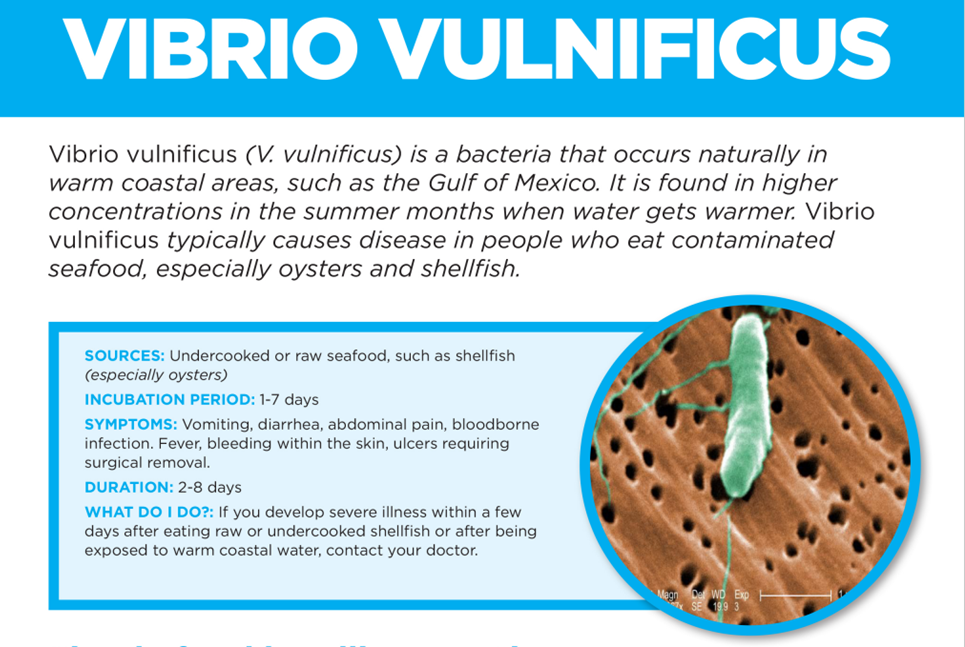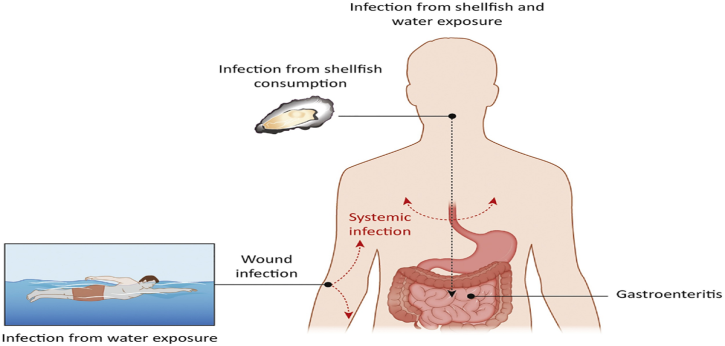Description

Copyright infringement not intended
Picture Courtesy: saniprofessional.com
Context: Vibrio vulnificus is a marine bacterium that has the potential to become a significant threat to coastal populations in the future. This bacterium is expected to proliferate due to the ideal environmental conditions resulting from warmer oceans and high rainfall.
More details about Vibrio Vulnificus
Origin and Transmission
- Vibrio vulnificus is naturally found in marine environments, particularly in warm coastal waters with low salinity. It can enter the human body through two main routes:
- People can contract Vibrio vulnificus by eating raw or undercooked seafood contaminated with the bacterium. This can lead to symptoms such as diarrhoea, vomiting, and fever.
- Another mode of transmission is through open wounds or cuts coming into contact with waters where Vibrio vulnificus is present. This can result in a severe and potentially life-threatening flesh-eating disease, with a mortality rate of 15-50%.

Picture Courtesy: www.cell.com
Symptoms of Vibrio vulnificus infection can vary depending on the mode of transmission
- Consumption of Infected Raw Shellfish: When ingested, Vibrio vulnificus can cause symptoms such as diarrhoea, vomiting, abdominal pain, and fever. In some cases, these symptoms can be severe, especially in individuals with weakened immune systems.
- Exposure to Wounds: When the bacterium enters the body through wounds, it can lead to localized symptoms such as pain, swelling, and redness at the site of infection. This can progress to necrotizing fasciitis, a life-threatening condition characterized by the rapid death of skin and soft tissue. If the infection enters the bloodstream, it can result in septicemia, which can lead to more severe symptoms, including high fever, confusion, and organ failure.
High-Risk Groups
- Certain individuals are at a higher risk of severe Vibrio vulnificus infections, including those with comorbidities such as chronic liver disease, cancer, chronic kidney disease, and diabetes. Immunocompromised individuals are also more susceptible to the bacterium.
Cure
- Antibiotics are often administered to combat the infection. However, the effectiveness of treatment decreases if the bacterium has entered the bloodstream.
- In severe cases, especially when the infection has progressed to gangrene or septicemia, surgical procedures such as amputation may be necessary.

Conclusion
- Vibrio vulnificus poses a significant health risk, particularly in regions with warm coastal waters. Understanding its transmission, symptoms, and the importance of early medical intervention is essential in mitigating the threat it poses to coastal populations. Efforts are also being made to track and predict its abundance to manage human health risks.
|
PRACTICE QUESTION
Q. Consider the following statements:
Statement 1: Vibrio vulnificus infections are more severe in individuals with comorbidities like chronic liver disease, cancer, chronic kidney disease, and diabetes.
Statement 2: Immunocompromised individuals are less susceptible to Vibrio vulnificus infections.
Which one of the following is correct in respect of the above statements?
A) Both Statement-1 and Statement-2 are correct and Statement-2 is the correct explanation for Statement-1
B) Both Statement-1 and Statement-2 are correct and Statement-2 is not the correct explanation for Statement-1
C) Statement-1 is correct but Statement-2 is incorrect
D) Statement-1 is incorrect but Statement-2 is correct
Answer: C
Explanation:
Statement 1 is correct as it correctly states that Vibrio vulnificus infections are more severe in individuals with comorbidities. However, Statement 2 is incorrect, as immunocompromised individuals are more susceptible to Vibrio vulnificus infections, not less.
|












